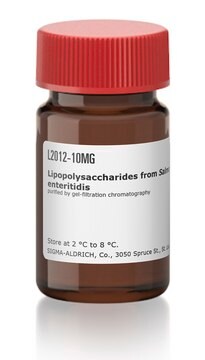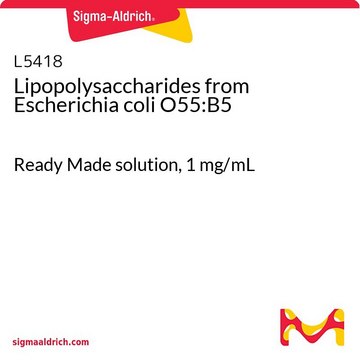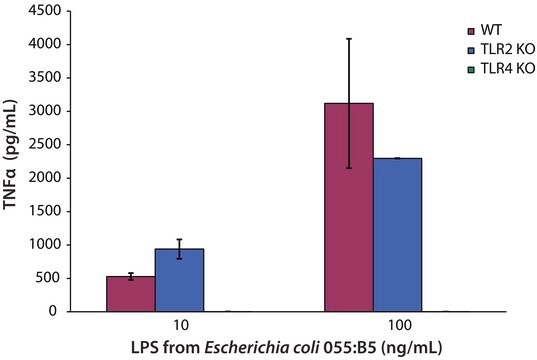L1887
Lipopolysaccharides from Salmonella enterica serotype abortus equi
purified by gel-filtration chromatography
Sinonimo/i:
LPS
Autenticatiper visualizzare i prezzi riservati alla tua organizzazione & contrattuali
About This Item
Prodotti consigliati
Origine biologica
Salmonella enterica (Serotype abortus equi)
Stato
lyophilized powder
Purificato mediante
gel-filtration chromatography
Impurezze
<1% Protein
Condizioni di spedizione
ambient
Temperatura di conservazione
2-8°C
Cerchi prodotti simili? Visita Guida al confronto tra prodotti
Descrizione generale
This product is extracted and purified by gel filtration from Salmonella abortus equi and purified by gel filtration. The source strain is ATCC 9842. Lipopolysaccharide from Salmonella abortus equi stimulates human mononuclear cells to produce tumor necrosis factor. This LPS is also mitogenic for frog and mouse lymphocytes.
Applicazioni
Lipopolysaccharides (LPSs) are characteristic components of the cell wall of Gram-negative bacteria. LPS and its lipid A moiety stimulate cells of the innate immune system by the Toll-like receptor 4 (TLR4), a member of the Toll-like receptor protein family, which recognizes common pathogen-associated molecular-patterns (PAMPs).
Azioni biochim/fisiol
Lipopolysaccharides (LPS) are localized in the outer layer of the membrane and are, in noncapsulated strains, exposed on the cell surface. They contribute to the integrity of the outer membrane, and protect the cell against the action of bile salts and lipophilic antibiotics.
Nota sulla preparazione
The product is soluble in water (5 mg/ml) or cell culture medium (1 mg/ml) yielding a hazy, faint yellow solution. A more concentrated, though still hazy, solution (20 mg/ml) has been achieved in aqueous saline after vortexing and warming to 70-80 oC. Lipopolysaccharides are molecules that form micelles in every solvent. Hazy solutions are observed in water and phosphate buffered saline. Organic solvents do not give clearer solutions. Methanol yields a turbid suspension with floaters, while water yields a homogeneously hazy solution.
Sigma typically tests the solubility of FITC dextrans in water at concentrations at or above 25 mg/ml. Solutions should be protected from light. In vivo, FITC-dextran is stable for more than 24 hours.
Sigma typically tests the solubility of FITC dextrans in water at concentrations at or above 25 mg/ml. Solutions should be protected from light. In vivo, FITC-dextran is stable for more than 24 hours.
Altre note
To gain a comprehensive understanding of our extensive range of Lipopolysaccharides for your research, we encourage you to visit our Carbohydrates Category page.
Prodotti correlati
Avvertenze
Danger
Indicazioni di pericolo
Consigli di prudenza
Classi di pericolo
Acute Tox. 2 Oral
Codice della classe di stoccaggio
6.1A - Combustible acute toxic Cat. 1 and 2 / very toxic hazardous materials
Classe di pericolosità dell'acqua (WGK)
WGK 3
Punto d’infiammabilità (°F)
Not applicable
Punto d’infiammabilità (°C)
Not applicable
Scegli una delle versioni più recenti:
Possiedi già questo prodotto?
I documenti relativi ai prodotti acquistati recentemente sono disponibili nell’Archivio dei documenti.
I clienti hanno visto anche
Matthew Hoffmann et al.
Xenobiotica; the fate of foreign compounds in biological systems, 41(12), 1063-1075 (2011-08-24)
Apremilast is a novel, orally available small molecule that specifically inhibits PDE4 and thus modulates multiple pro- and anti-inflammatory mediators, and is currently under clinical development for the treatment of psoriasis and psoriatic arthritis. The pharmacokinetics and disposition of [(14)C]apremilast
Kanchan Phadwal et al.
Autophagy, 8(4), 677-689 (2012-02-04)
Autophagy is a conserved constitutive cellular process, responsible for the degradation of dysfunctional proteins and organelles. Autophagy plays a role in many diseases such as neurodegeneration and cancer; however, to date, conventional autophagy detection techniques are not suitable for clinical
Pau Gonzalez et al.
Neuroscience research, 114, 16-29 (2016-08-27)
Despite the essential functions of astrocytes and the emerging relevance of the Wnt family of proteins in the CNS under physiological and pathological conditions, the astroglial expression of this family of proteins and its potential modulatory role on astroglial activation
Il team dei nostri ricercatori vanta grande esperienza in tutte le aree della ricerca quali Life Science, scienza dei materiali, sintesi chimica, cromatografia, discipline analitiche, ecc..
Contatta l'Assistenza Tecnica.




